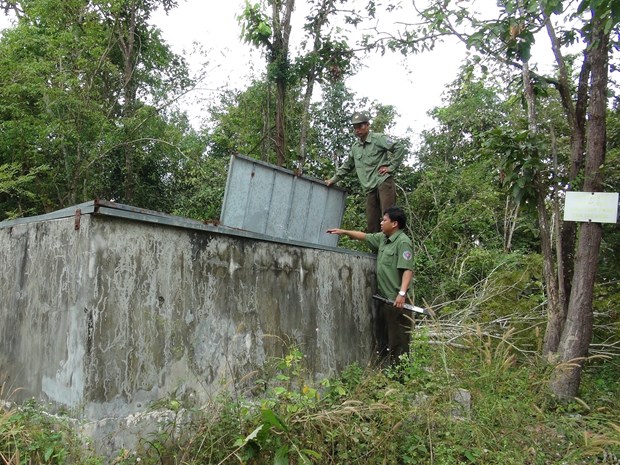 Environment
Environment

 |
| Rangers check a water tank in Bù Đốp District's forest. VNA/VNS Photo |
BÌNH PHƯỚC - Thousands of hectares of forest in Bù Đốp District, Bình Phước Province, are being better managed and protected thanks to the cooperation of residents and authorities.
“The forest protection force has been strengthened to ensure the forests are not affected by fire, deforestation and violations of the forest protection law, especially in the last days of the year, as well as the upcoming Lunar New Year holiday," said Nguyễn Thành Vinh, deputy director of the Bù Đốp Protective Forest Management Board.
The unit is assigned to protect 8,500ha of forest, including 6,500ha of natural forest.
The province has invested in building 40 water tanks to respond to fires promptly, Vinh said.
The construction of concrete water tanks in the forest has brought high efficiency in protecting forests from fires.
There are four community-based groups with 120 members participating in protecting forests. Each member is protecting 30ha of forest.
The people involved in forest protection have been divided into groups to protect the forest better. Members of each group take turns patrolling the forests.
Điểu Ngớt, a resident from Phước Thiện Commune, said he began participating in community-based groups to protect the forest in 2021, helping improve his family's life.
"Local people are very happy because they can join hands to protect the forests and keep them green. Protecting the forest is protecting the living environment."
"Eating and sleeping in the forest and walking tens of kilometres through mountains and rivers, and streams during patrolling days have become familiar works of forest protectors," said Điểu Gôn, a member of forest protectors in Phước Thiện Commune.
"Years ago, forest protection had not been paid attention to by local people. They often went to the forest to hunt, collect bamboo shoots, honey, and medicinal herbs, and burn forests for farming. However, in recent years, the number of forest law violations has decreased significantly," Điểu Ngớt said.
Forest rangers and people involved in forest protection have strengthened patrols, especially hot spots of deforestation, forest fires, and encroachment on forest land.
"We also learn the customs and habits of local people and then mobilise them to participate in forest protection," he said.
The forest management board has also worked closely with local authorities to propagate and raise awareness about forest prevention and ask households living near the forest to sign a commitment not to violate forest regulations or encroach on the forest land, according to Vinh.
"The entire forest area managed by the unit is safe, and community-based groups also do their job well."
Forest protection in the locality is also improving thanks to the policy of payment for forest environmental services.
"This could be the driving force for locals to protect the forests and prevent forest fires," said Vinh.
The policy has also contributed to improving the lives of ethnic minority groups, creating jobs and higher incomes.
Afforestation also helps people earn more money and raises a sense of responsibility for forest protection.
In addition to strengthening the protection of existing forest areas, Bình Phước Province has promoted the expansion of forests in semi-submerged areas.
The province has about 2,000 hectares of semi-submerged areas, mainly along the Cần Đơn and Thác Mơ hydropower reservoirs in Bù Đốp, Bù Gia Mập, Bù Đăng districts and Phước Long Township.
Nguyễn Văn Ách, former head of Bù Đốp forest ranger station, said the energy demand had greatly affected the environment, causing the decline of forests.
"I thought it was possible to take advantage of semi-submerged areas by hydropower dams and reservoirs to plant trees, helping to prevent land erosion and reduce the negative impact of hydropower projects on the environment. My colleagues and I began our project," Ách said.
After seven years of farming with many failures, nearly 40 hectares of semi-submerged areas in Cần Đơn reservoir have been covered with gáo vàng and cajeput trees, which also attracts more amphibians to live. VNS




